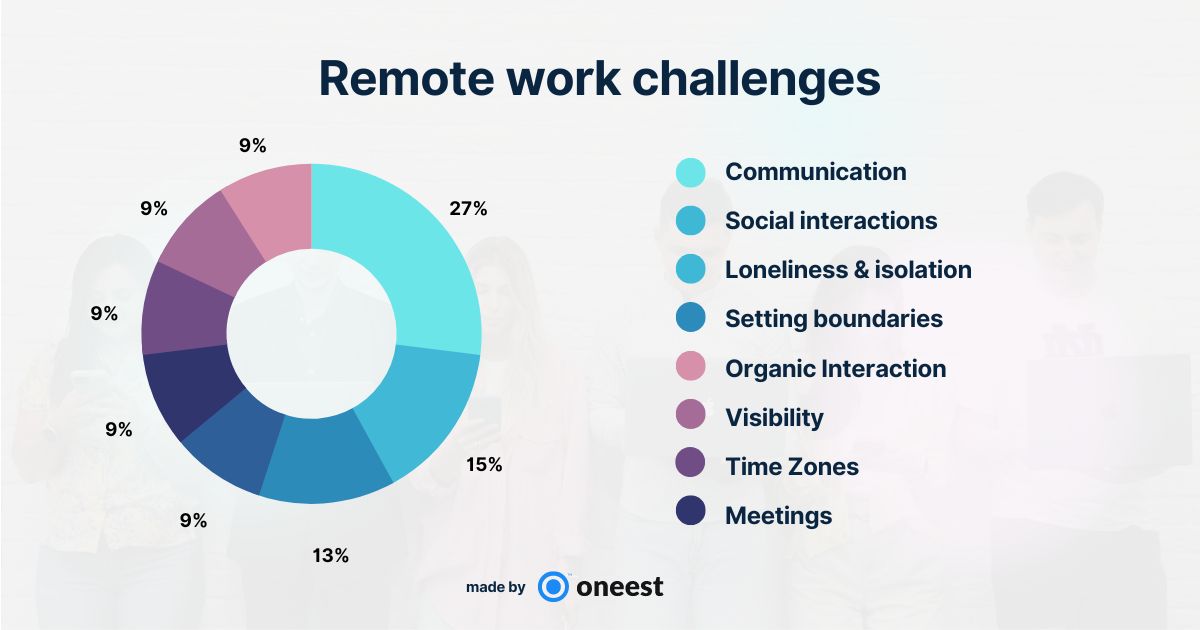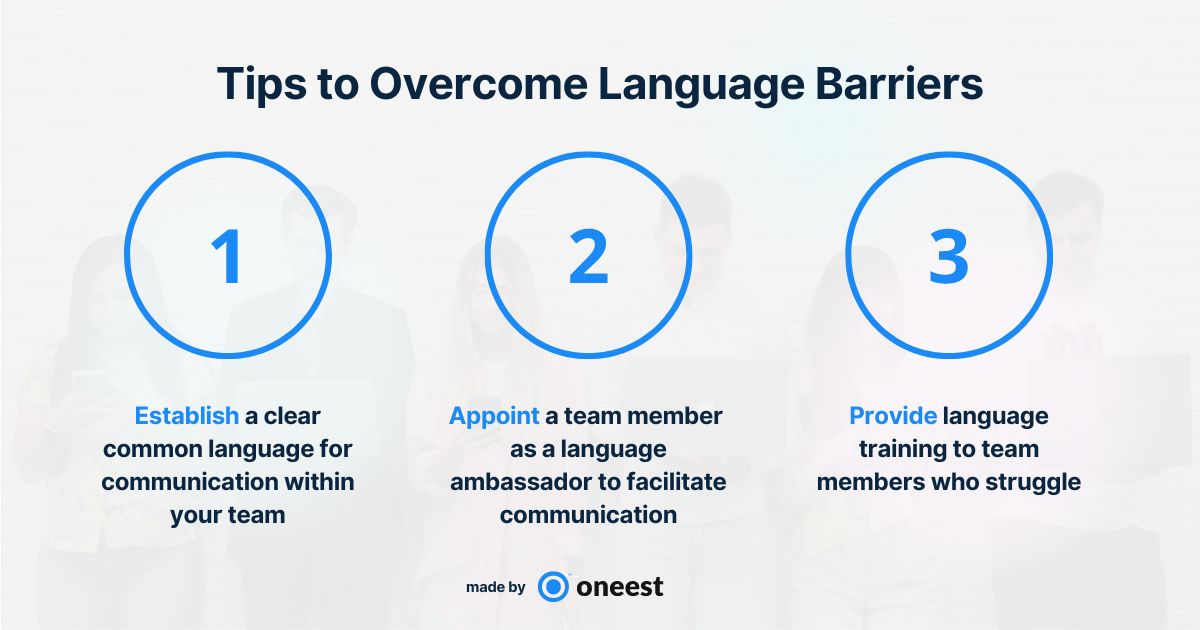With COVID-19 remote work has become a reality & normality. The pandemic has caused many companies to reassess their approach to work and embrace remote teams as a viable alternative to traditional in-person work.
Remote work comes with many advantages, enabling companies to tap into a global talent pool to find professionals. It can also lead to reduced costs, greater employee satisfaction, and increased productivity.
However, managing a remote software development team comes with its own set of unique challenges, one of which is effective communication.
Why Communication is Fundamental for Remote Development Teams?
Want to know what defective communication can lead to? Just imagine a tower that was meant to reach the skies, yet, due to the inability of the builders to understand each other, it remained unfinished and incomplete.
"The Tower of Babel" is a clear representation of what the lack of communication can cause. Nobody wants to reach this outcome.

How can a team work together effectively if they can’t understand each other's messages? How can they meet their objectives if they don't have a common understanding of what needs to be done?
Effective communication is crucial for remote software development teams to function smoothly and deliver high-quality work. It is the cornerstone of building trust, alignment, and collaboration among team members.
Without effective communication, remote teams may struggle to understand the other team members. This issue would result in delays and even project failure.
Thus, let's not make the same mistakes as the builders of the Tower of Babel and instead, build a strong foundation of communication in our remote teams.
Nira, a Document Access Control startup based out in San Francisco, surveyed over 500 people about remote work, and below are the remote work challenges that people face when working remotely (check out their entire Remote Work Report):

As you see, communication is the #1 challenge in remote work, and communication for remote software development teams isn't an exception. Even bigger companies like Meta, Google, Amazon, IBM, Apple & others face this challenge too.
A few specific challenges related to communication and collaboration that remote development teams face are language barriers, time zone differences, and lack of face-to-face interaction.
These challenges can make it difficult to establish a clear line of communication and ensure that everyone is on the same page. But effective communication is not only about avoiding misunderstandings and delays. It is also a powerful tool for building a strong team culture, fostering innovation, and creating a positive work environment.
At Oneest, we understand the vital role that effective communication plays in the success of remote software development teams.
In the past, we faced challenges of this kind ourselves but with the openness of our clients and the effort of our teams, we were able to overcome them and establish effective communication and collaboration practices. That's why we believe that sharing our experience and the strategies we have implemented might be useful to others.
In this article, we'll explore the common challenges faced by remote software development teams and provide guidance on how to overcome them. We will share our insights on how Oneest as a top Java development company in Eastern Europe ensures effective communication and collaboration in our remote software development teams and provide examples of how our strategies have contributed to the success of our projects.
By understanding the unique challenges and taking the necessary steps to overcome them, companies can ensure that their remote software development teams are productive, efficient, and successful.
What are the common communication challenges remote software development teams face?
As more and more companies embrace the imperatives of the 21st century and switch to remote work, it's important to understand and address the unique challenges that come with this type of work environment.
We'll dive into three of the most common challenges that remote software development teams face: language barriers, time zone differences, and lack of face-to-face interaction. And we'll give you actionable tips on how to overcome them and take your team's collaboration and communication to the next level.
Language barriers
Let's face it, language barriers can be a real roadblock to effective communication and collaboration within a remote software development team.

When team members come from different countries and speak different languages, it can be difficult to communicate effectively and understand each other's ideas and feedback.
But don't worry, with a little bit of planning and effort, you can easily overcome this challenge.
First and foremost, establish a clear and common language for communication within your team. Make sure that everyone is comfortable using this language, and if necessary, consider hiring a translator or a bilingual team member to help facilitate communication.
Appointing a team member who speaks multiple languages as a language ambassador can help to facilitate communication and bridge any language barriers that may arise. This person can act as a translator and help to ensure that everyone is updated and can understand what are the messages, conversations, and announces about.
Additionally, consider using translation software or services to help bridge any language gaps.
If a majority of the team speaks one language and some team members struggle with it, providing language training can help to bridge the communication gap. This can be done through online language classes or by hiring a language tutor.

Time zone differences
It is a common practice when working remotely to have the team members spread out across different locations and time zones.
When the team members work in different time zones, it can be difficult to coordinate schedules and have synchronous meetings and discussions. But with a little bit of planning and flexibility, you can easily puzzle out this challenge.
On their blog, Miro often dedicates entire articles to how they manage distributed teams in different timezones, like for example with the use of Google Calendar features to schedule meetings.

So how do you master overcoming time-zone differences when having remote development teams? First, establish clear guidelines for when team members are available and try to schedule meetings and check-ins during times when most team members are online.
Other useful tools are project management platforms that allow team members to see each other's availability in real-time. This can help to coordinate schedules and avoid scheduling conflicts.
For example, you can use a platform like Google Calendar (Workspace v.), ActiveCollab, Trello, Slack, or ClickUp which includes a built-in calendar feature.
This way, the team members can see when the others are available or busy.
Remember to be flexible and willing to accommodate team members who are in different time zones. This may mean scheduling some meetings outside of regular working hours or being willing to have asynchronous discussions when necessary.
By being flexible and understanding, remote software development teams can overcome the challenges posed by time zone differences and work effectively despite geographical barriers.
Lack of face-to-face interaction
This can be a major contributor to decreased collaboration. It goes against the Agile principle of having face-to-face interaction and working together daily throughout the project:
"The most efficient and effective method of conveying information to and within a development team is face-to-face conversation."
While email and instant messaging can be useful, they can also be overwhelming and lead to miscommunication. When working remotely, it can be difficult to read body language and tone, leading to misinterpretation and frustration.
How often have you had to navigate unclear expectations or unclear directions in a remote work setting? The absence of in-person interaction can also result in a lack of accountability and a decrease in team morale.
Without the opportunity for team members to connect and build relationships on a personal level, it can be challenging to develop a sense of unity and trust within a remote team. But don't let that stop you from building a strong and cohesive team.
At Oneest, we understand the importance of Agile practices, thus we try to meet during Agile ceremonies and adopt other methods that our team collaboratively chooses for itself. The solution lies in implementing effective communication strategies to mitigate the negative impacts of remote work:
- 1. Make an effort to have virtual meetings and conversations that mimic face-to-face interactions as much as possible. They would create a sense of presence and provides a more connected experience; thus, the teamwork becomes more similar to in-person interactions.
- 2. Encouraging team members to turn on their cameras during meetings, can also help to build personal relationships and create a more human connection between team members. By turning on the cameras during video meetings, team members have the opportunity to observe each other's facial expressions, body language, and other visual cues, which greatly improves communication and comprehension.
- 3. Schedule regular team-building activities. This can help to keep the team connected and engaged, despite being physically separated. For example, you can organize virtual happy hours, online games, or other social activities that allow team members to bond and connect with each other. These activities can help to build a sense of community and maintain a positive and collaborative team dynamic.
- 4. Prioritize clear and open communication, especially when working remotely. This can help to ensure that team members are always on the same page and working towards the same goals.
- 5. Regular check-ins, project updates, and progress reports can help maintain transparency and ensure that everyone is aware of what's happening in the team.
By addressing and overcoming these common challenges, you'll be well on your way to creating a high-performing and effective remote software development team. So, don't let distance and language barriers hold you back, with the right tools and mindset, you can easily create a collaborative and productive team culture.
How to overcome the communication and collaboration challenges for remote software development teams?
Now that we've identified some of the common challenges that remote software development teams face, we'll explore three key strategies to overcome them: using communication tools, setting clear expectations and goals, and establishing a strong team culture.
By implementing these strategies, you'll be well on your way to creating a high-performing and effective remote software development team.
Using communication tools

It's essential to establish a clear communication plan from the beginning of any project. This should include clearly defined roles and responsibilities for each team member.
With so many communication tools available, it can be overwhelming to choose the right ones for your team. But don't worry, a little bit of research and experimentation can go a long way.
Some popular options include instant messaging, video conferencing, and project management tools. Consider your team's specific needs and choose tools that will help facilitate clear and efficient communication.
Every company whether it promotes remote, hybrid, or on-site work, should have a communication toolkit tailored to its needs. For example, Miro's communication toolkit includes tools for different types of communication - ongoing, real-time, transactional, and connective.
Later in this article, we will share with you the most useful and suitable platforms that have already been tested by our company.
By sharing our experience, we hope to provide you with the information you need to make informed decisions about which tools and platforms will work best for your remote software development team.
Our goal is to make sure we keep you updated with the latest developments and best practices in this field so that you can stay ahead of the curve and build a high-performing and effective remote software development team.
Setting clear expectations and goals
Each team member must have a clear understanding of their role and responsibilities so everyone knows their tasks and is able to focus on their specific area of expertise.
This clear understanding of the roles can be achieved through job descriptions, performance objectives, or regular team meetings where roles and responsibilities are discussed and agreed upon.
It's also important to set clear and measurable team goals that are aligned with the project objective, broken down into manageable tasks, and regularly reviewed through check-ins. These goals can be in the form of project deliverables, milestones, or deadlines and should be communicated regularly to all team members during the Agile ceremonies.
By setting clear expectations and goals, remote teams can work more effectively towards their objectives and achieve better results.
Establishing a strong team culture
One of the most important strategies for overcoming communication and collaboration challenges in remote software development teams is to establish a strong team culture. To do this, consider the following strategies:

To do this, you'll need to be intentional and make an effort to build a team culture that supports collaboration and communication.
Remote software development teams can be challenging to manage, but with the right strategies in place, you can overcome the common challenges of communication and collaboration.
By using communication tools, setting clear expectations and goals, and establishing a strong team culture, you'll be well on your way to creating a high-performing and effective remote software development team.
So, don't let distance and language barriers hold you back, with the right tools and mindset, you can easily create a collaborative and productive team culture.
How Oneest ensures effective communication within our remote software development teams?
At Oneest, we understand the unique challenges that remote software development teams face, and we've put in place a number of strategies to ensure effective communication and collaboration.
We'll take a look at three key strategies that we use to overcome these challenges: using communication tools and platforms, conducting regular check-ins, and developing a strong team culture.
Use of communication tools and platforms
For remote dedicated development teams, having the right communication tools and platforms is of utmost importance for effective communication and collaboration among team members.
Finding the perfect fit for your team can take some experimentation and exploration, but it's well worth the effort. Some of the tools and platforms we use:
- Miro board for virtual workshops, project discovery meetings, product development roadmaps & brainstorming sessions
- Slack as an internal messaging tool, both formal & informal
- Google Workspace for emails, files, documentation sharing, meetings & calendar
- Google Meet & Zoom as video conferencing tools
- Trello & ActiveCollab for project management, time tracking & monitoring
Each tool has its own set of advantages and disadvantages, and the most effective way to utilize them is by combining a few of them to meet the various communication needs of the team.
For example, Slack is an excellent tool for real-time communication, providing instant messaging and the possibility to form channels for specific projects, teams, or departments.
Google Workspace, on the other hand, offers robust document collaboration features, making it ideal for sharing and editing documents among team members.
Trello, on the other hand, is a great project management tool that provides a visual representation of the project, making it easy to track progress and manage tasks.
We recommend you check out what each of them can offer you, to determine which is the most suitable for satisfying your team's needs.
The importance of regular check-ins
Regular check-ins are an essential part of our communication and collaboration strategy at Oneest. These check-ins help to keep our remote teams on track and aligned, and they provide a valuable opportunity for team members to share updates, ask questions, and provide feedback. We schedule regular check-ins, such as weekly progress reports, and we make sure to conduct them in a structured and effective way.
For example, we use a specific agenda and stick to a set time limit to ensure that the check-ins are productive and efficient. Our team has come to rely on these check-ins as an important part of their work time and they appreciate the opportunity to touch base with their colleagues and discuss the progress of their projects.

Regular check-ins also provide a platform for addressing any challenges or obstacles that may arise. They provide an opportunity for team members to voice their concerns, and for team leaders to provide guidance and support.
Furthermore, regular check-ins allow for real-time feedback and help to prevent misunderstandings or miscommunications from happening.
By having regular check-ins, our team is able to identify potential problems at an early stage of their occurrence and work together to find solutions.
The role of culture and values
Building a company culture and a common system of values play a significant role in the success of remote software development teams.
At Oneest, we believe that fostering a team culture that supports communication and collaboration is crucial for achieving high performance and delivering high-quality work.
We aim to create an environment where team members feel valued and supported, and where they can communicate openly and effectively.
To support this goal, we established a set of core values that guide our interactions and decision-making: trust, open communication, teamwork, accountability, and respect, are some of the values that guide us. As part of our approach, these values help us to build a sense of unity and purpose within the team and ensure that everyone is working towards the same goals.
Another key aspect of our team culture is community building.
We understand that remote teams can lack the sense of community that is present in traditional work environments.

To overcome this challenge, we organize regular team-building activities and events. These activities not only help to build relationships, and create a sense of belonging among team members, but they also help us strengthen our company value system and make sure everyone in our team resonates with our common values.
It’s important to note that, although we try to build a set of common values, we promote and encourage diversity.
Having a diverse team of individuals from different backgrounds, experiences, and perspectives brings new ideas and approaches to the table. While it's important to have shared values and a strong team culture, embracing diversity is crucial for building an inclusive and dynamic team.
When everyone feels valued and respected, they are more likely to contribute fully and share their unique perspectives, leading to better outcomes and solutions.
Additionally, having a diverse team helps to build a better company culture, increase employee satisfaction, and create a more competitive and innovative work environment.
By putting a strong emphasis on culture and values, Oneest is able to overcome the challenges that remote teams face and create a cohesive, and effective team.
Our culture and values support the development of strong relationships and create a sense of community that is essential for effective communication and collaboration in remote software development teams.
Summing Up
Oneest team has found that using the right communication tools and platforms, conducting regular check-ins, and fostering a strong team culture are essential strategies for ensuring effective communication and collaboration in remote software development teams.
By implementing these strategies, we're able to overcome the common challenges that remote teams face, and we're able to create a high-performing and effective work environment.
Moreover, we also encourage our team members to be proactive in their communication and to ask for help when needed. We believe that open and transparent communication is the key to overcoming any communication challenges that may arise in a remote work setting.
This also helps to build trust and to provide a positive work environment where team members feel supported and valued. With the right approach, remote software development teams can deliver outstanding results, even when working from different locations and time zones.
If you're looking for a reliable software development company or want to hire your own remote dedicated development team in Eastern Europe, we are happy to help you to bring your idea to life and build for you a product that your customers will love and your business will flourish.
Get in touch with us if you want to discuss your project, need a development plan, or expert advice. We work with many mid-market businesses and startups and would be happy to make our experience work for you.